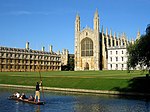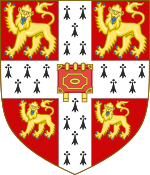King's College Chapel, Cambridge
Chapels of Colleges of the University of CambridgeGrade I listed buildings in CambridgeGrade I listed churches in CambridgeshireKing's College, CambridgeReligious buildings and structures completed in 1515 ... and 2 more
Tudor architectureUse British English from February 2023

King's College Chapel is the chapel of King's College in the University of Cambridge. It is considered one of the finest examples of late Perpendicular Gothic English architecture and features the world's largest fan vault. The Chapel was built in phases by a succession of kings of England from 1446 to 1515, a period which spanned the Wars of the Roses and three subsequent decades. The Chapel's large stained glass windows were completed by 1531, and its early Renaissance rood screen was erected in 1532–36. The Chapel is an active house of worship, and home of the King's College Choir. It is a landmark and a commonly used symbol of the city of Cambridge.
Excerpt from the Wikipedia article King's College Chapel, Cambridge (License: CC BY-SA 3.0, Authors, Images).King's College Chapel, Cambridge
King's Parade, Cambridge Newnham
Geographical coordinates (GPS) Address External links Nearby Places Show on map
Geographical coordinates (GPS)
| Latitude | Longitude |
|---|---|
| N 52.2048 ° | E 0.1165 ° |
Address
King's College Chapel
King's Parade
CB2 1ST Cambridge, Newnham
England, United Kingdom
Open on Google Maps










